
Unit 5: Indigenous Americas, 1000 BCE–1980 CE
Contextualization of Indigenous Americas Art
Chavin: Their art created intricate stone carvings and pottery, often depicting their gods and animals.
Mayan: They were known for their elaborate architecture, intricate carvings, and colorful murals.
Anasazi: They created beautiful pottery and rock art, often depicting their daily lives and spiritual beliefs.
Mississippian: They produced intricate copper and shell ornaments, as well as impressive earthen mounds.
Aztec: They were skilled in metalworking, creating intricate gold and silver jewelry, as well as colorful featherwork.
Incan: They were known for their impressive stonework, including the famous Machu Picchu.
Native North American: Their art varied greatly depending on the tribe, but often included intricate beadwork, basketry, and carvings.
Materials, Processes and Techniques in Indigenous American Art
Mesoamerica
They used stone, clay, wood, feathers, shells, and precious metals such as gold and silver.
Stones were used to create sculptures, buildings, and other structures.
Their processes include carving, casting, weaving, and painting.
Carving: Used create sculptures and other objects out of stone, while casting was used to create metal objects.
Weaving: Used to create textiles, which were often decorated with intricate designs.
Painting: Used to decorate buildings, sculptures, and other objects, and often used bright colors and bold designs.
Techniques used in Mesoamerican art include relief sculpture, mosaic, and inlay.
Relief sculpture: Involves carving a design into a flat surface, while mosaic involves creating a design out of small pieces of stone or other materials.
Inlay: Involves setting small pieces of one material into another material to create a design.
Central Andes
Pre-Columbian art used gold, silver, and copper to create intricate jewelry and ceremonial objects, and textiles were also important.
During colonial times, European materials were introduced, leading to new painting techniques like the Cuzco School.
Today, artists use a variety of materials and techniques, blending traditional and contemporary styles, experimenting with new materials, and exploring different art forms.
Native North America
Natural materials like wood, stone, bone, and animal hides, as well as trade materials like glass beads, metals, and textiles are used.
Art is created through carving, weaving, painting, and quilling.
Basketry, pottery, and jewelry making are common techniques.
These methods reflect cultural and spiritual beliefs and can tell stories, record history, or celebrate events.
Traditional methods have adapted to modern materials and technologies.
Indigenous Americas Artworks
➼ Chavín de Huántar
Details
900–200 B.C.E.
Stone
Found in Northern Highlands, Peru
Function
A religious capital.
Temple, 60 meters tall, was adorned with a jaguar sculpture, a symbol of power.
Hidden entrance to the temple led to stone corridors.
Relief sculpture
Shows jaguars in shallow relief.
Located on the ruins of a stairway at Chavín.
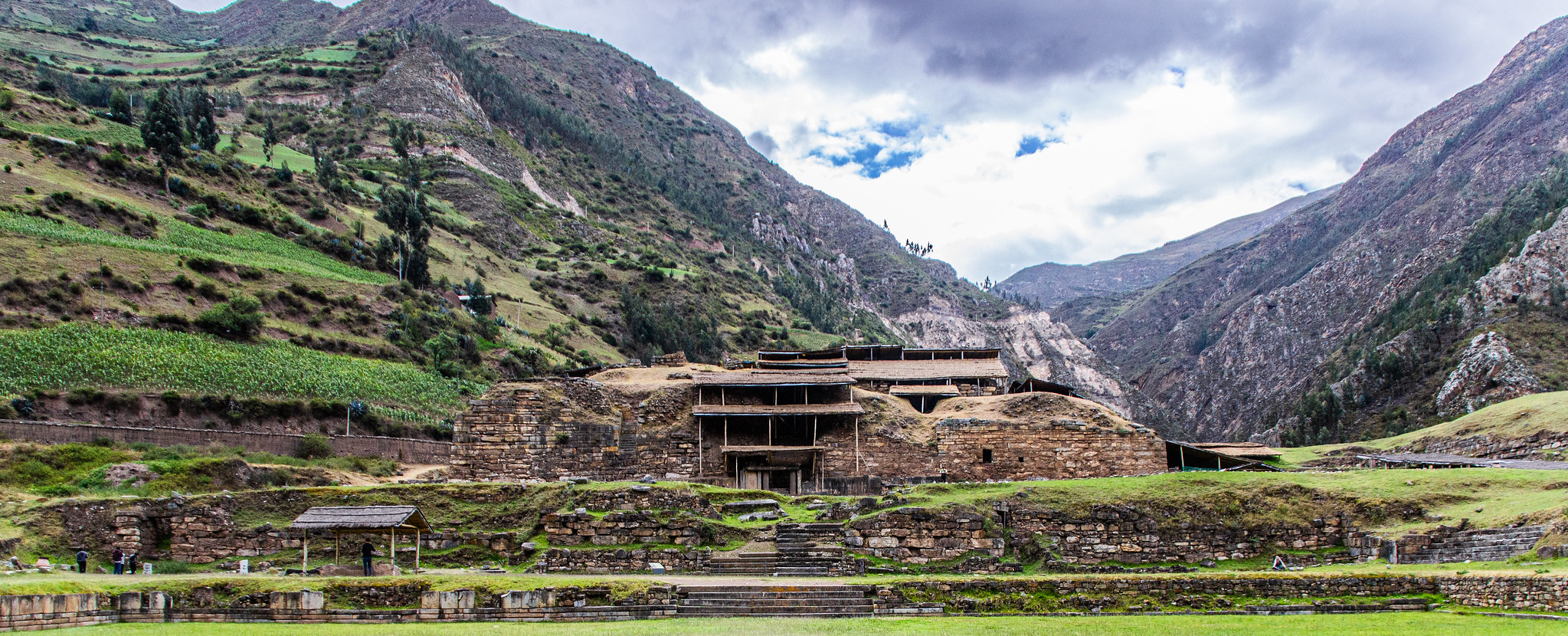
➼ Lanzón Stone
Details
900–200 B.C.E.
Granite
Found in Peru
Form
Inside the old temple of Chavín is a mazelike system of hallways.
Passageways have no natural light source; they are lit by candles and lamps.
At the center, underground, is the Lanzón (Spanish for “blade”) Stone; blade shaped; may also represent a primitive plough; hence, the role of the god in ensuring a successful crop.
Depicts a powerful figure that is part human (body) and part animal (claws, fangs); the god of the temple complex.
Head of snakes and a face of a jaguar.
Eyebrows terminate in snakes.
Flat relief; designs in a curvilinear pattern.
15 feet tall.
Function
Served as a cult figure.
Center of pilgrimage; however, few had access to the Lanzón Stone.
Modern scholars hypothesize that the stone acted as an oracle; hence a point of pilgrimage.
New studies show the importance of acoustics in the underground chamber.
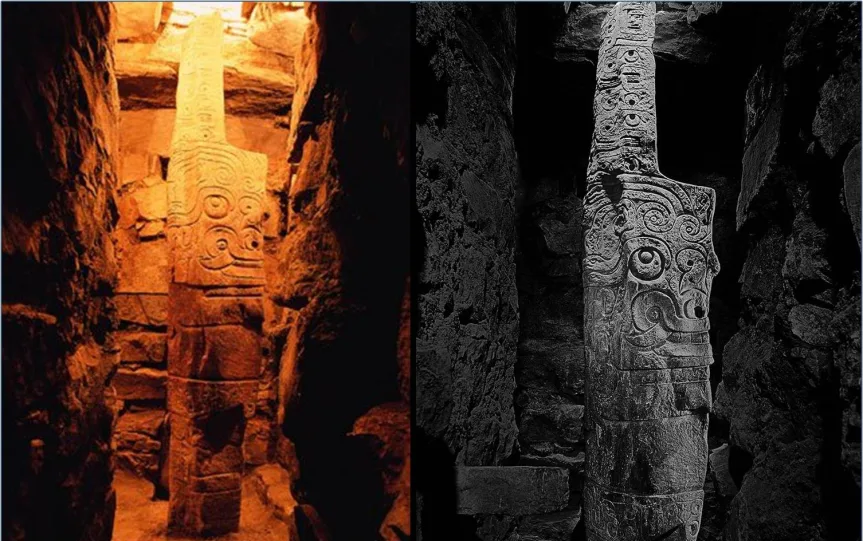
➼ Nose Ornament
Details
hammered gold alloy
Found in Cleveland Museum of Art
Form
Worn by males and females under the nose.
Held in place by the semicircular section at the top.
Two snake heads on either end.
Function: Transforms the wearer into a supernatural being during ceremonies.
Context
Elite men and women wore the ornaments as emblems of their ties to the religion and eventually were buried with them.
The Chavín religion is related to the appearance of the first large-scale precious metal objects; revolutionary new metallurgical process.
Technical innovations express the “wholly other” nature of the religion.

➼ Yaxchilán
Details
725 CE
limestone
Found in Chiapas, Mexico
Function
City set on a high terrace; plaza surrounded by important buildings.
Flourished c. 300–800 C.E.
➼ Structure 40
Details
Overlooks the main plaza.
Three doors lead to a central room decorated with stucco.
Roof remains nearly intact, with a large roof comb (ornamented stone tops on roofs).
Corbel arch interior.
Patronage: Built by ruler Bird Jaguar IV for his son, who dedicated it to him.
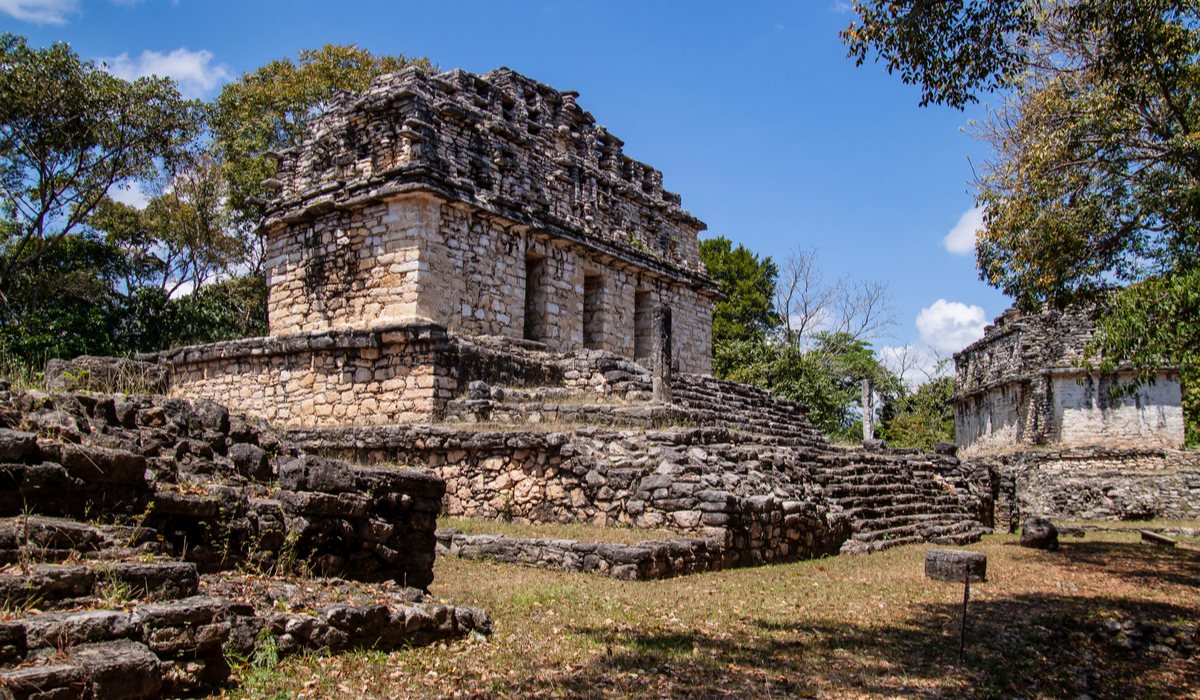
➼ Lintel 25, Structure 23
Details
Overlooks the main plaza.
Three doors lead to a central room decorated with stucco.
Roof remains nearly intact, with a large roof comb (ornamented stone tops on roofs).
Corbel arch interior.
Form and Content
The lintel was originally set above the central doorway of Structure 23 as a part of a series of three lintels.
Lady Xook (bottom right) invokes the Vision Serpent to commemorate her husband’s rise to the throne.
The Vision Serpent has two heads: one has a warrior emerging from its mouth, and the other has Tlaloc, a war god.
She holds a bowl with bloodletting ceremonial items: stinging spine and bloodstained paper; she runs a rope with thorns through her tongue.
She burns paper on a dish as a gift to the netherworld.
The depicted ritual was conducted to commemorate the accession of Shield Jaguar II to the throne.
Function
Lintels intended to relay a message of the refoundation of the site—there was a long pause in the building’s history.
Shield Jaguar’s building program throughout the city may have been an attempt to reinforce his lineage and his right to rule.
Context
The building is dedicated to Lady Xook, Shield Jaguar II’s wife.
The inscription is written as a mirror image—extremely unusual among Mayan glyphs; uncertain meaning, perhaps indicating she had a vision from the other side of existence and she was acting as an intercessor or shaman.
The inscription names the protagonist as Shield Jaguar II.
Bloodletting is central to the Mayan life. When a member of the royal family sheds his or her blood, a portal to the netherworld is opened and gods and spirits enter the world.
Theory: Some scholars suggest that the serpent on this lintel and elsewhere depicts an ancestral spirit or founder of the kingdom.
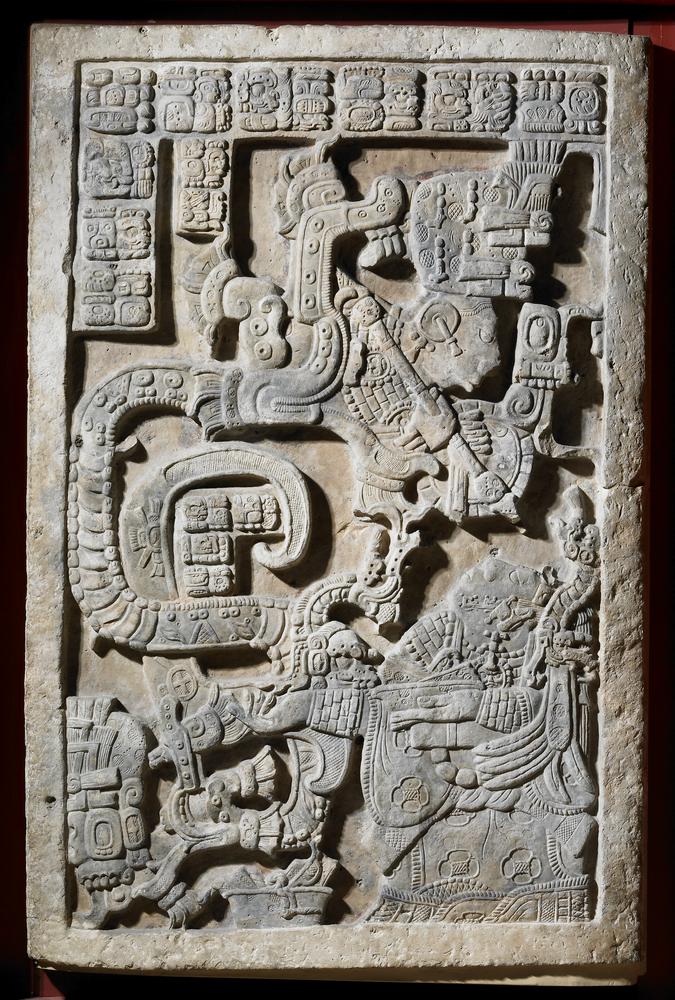
➼ Structure 33
Details
Overlooks the main plaza.
Three doors lead to a central room decorated with stucco.
Roof remains nearly intact, with a large roof comb (ornamented stone tops on roofs).
Corbel arch interior.
Form
Restored temple structure.
Remains of roof comb with perforations.
Three central doorways lead to a large single room.
Corbel arch interior.
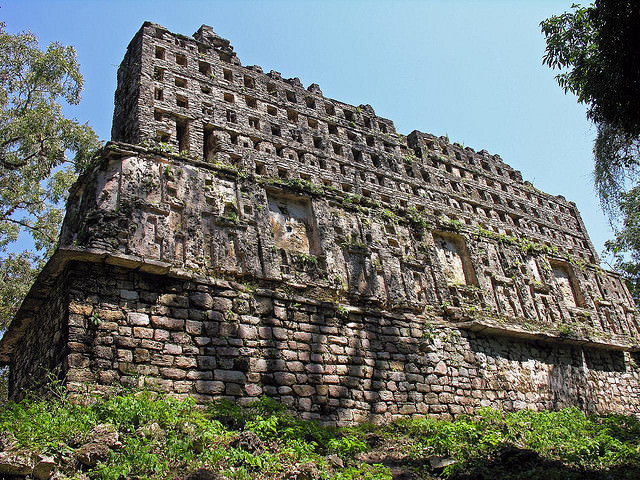
➼ Mesa Verde Cliff Dwellings
Details
Ancestral Puebloan (Anasazi)
450–1300 C.E.
Sandstone
Found in Montezuma County, Colorado
Form
The top ledge houses supplies in a storage area; cool and dry area out of the way; accessible only by ladder.
Each family received one room in the dwelling.
Plaza placed in front of the abode structure; kivas face the plaza.
Function
The pueblo was built into the sides of a cliff, housed about one hundred people.
Clans moved together for mutual support and defense.
Context
Farming done on the plateau above the pueblo; everything had to be imported into the structure; water seeped through the sandstone and collected in trenches near the rear of the structure.
Low winter sun penetrated the pueblo; high summer sun did not enter the interior and therefore it stayed relatively cool.
Inhabited for two hundred years; probably abandoned when the water source dried up.

➼ Great Serpent Mound
Details
Mississippian (Eastern Woodlands)
c. 1070 C.E.
earthwork/effigy mound
Found in Adams County, southern Ohio
Context
Many mounds were enlarged and changed over the years, not built in one campaign.
Effigy mounds popular in Mississippian culture.
Associated with snakes and crop fertility.
There are no burials associated with this mound, though there are burial sites nearby.
Theories
Influenced by comets? Astrological phenomenon? Head pointed to summer solstice sunset?
Theory that it could be a representation of Halley’s Comet in 1066.
Rattlesnake as a symbol in Mississippian iconography; could this play a role in interpreting this mound?
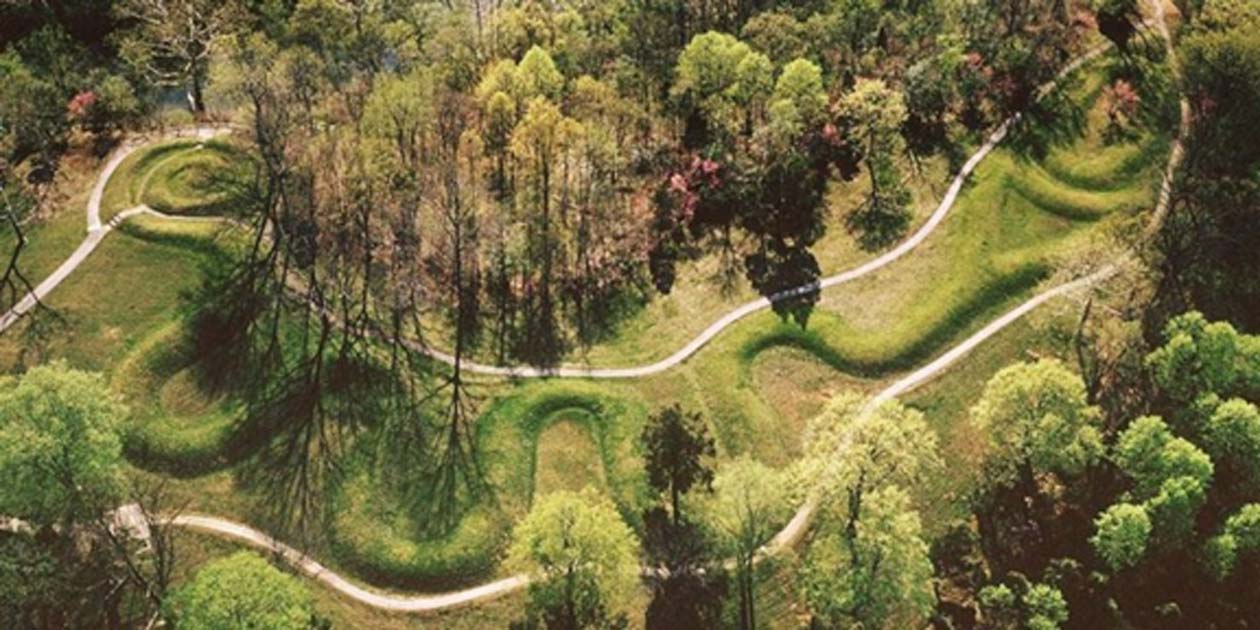
➼ Templo Mayor (Main Temple)
Details
1375–1520
Stone
Found in Tenochtitlán, Mexico City, Mexico
Form
Pyramids built one atop the other so that the final form encases all previous pyramids; seven building campaigns.
Pyramids have a step-like series of setbacks; not the smooth-surfaced pyramids seen in Egypt.
Characterized by four huge flights of very vertical steps leading to temples placed on top.
Function
Tenochtitlán was laid out on a grid; city seen as the center of the world.
The temple structures on top of each pyramid were dedicated to and housed the images of the two important deities.
Context
Two temples atop a pyramid, each with a separate staircase:
North: dedicated to Tlaloc, god of rain, agriculture.
South: dedicated to Huitzilopochtli, god of sun and war.
At the spring and autumn equinoxes, the sun rises between the two.
Large braziers put on top where the sacred fires burned.
Temple structures housed images of the deities.
Temples begun in 1375; rebuilt six times; destroyed by the Spanish in 1520.
The destruction of this temple and reuse of its stones by the Spanish asserted a political and spiritual dominance over the conquered civilization.
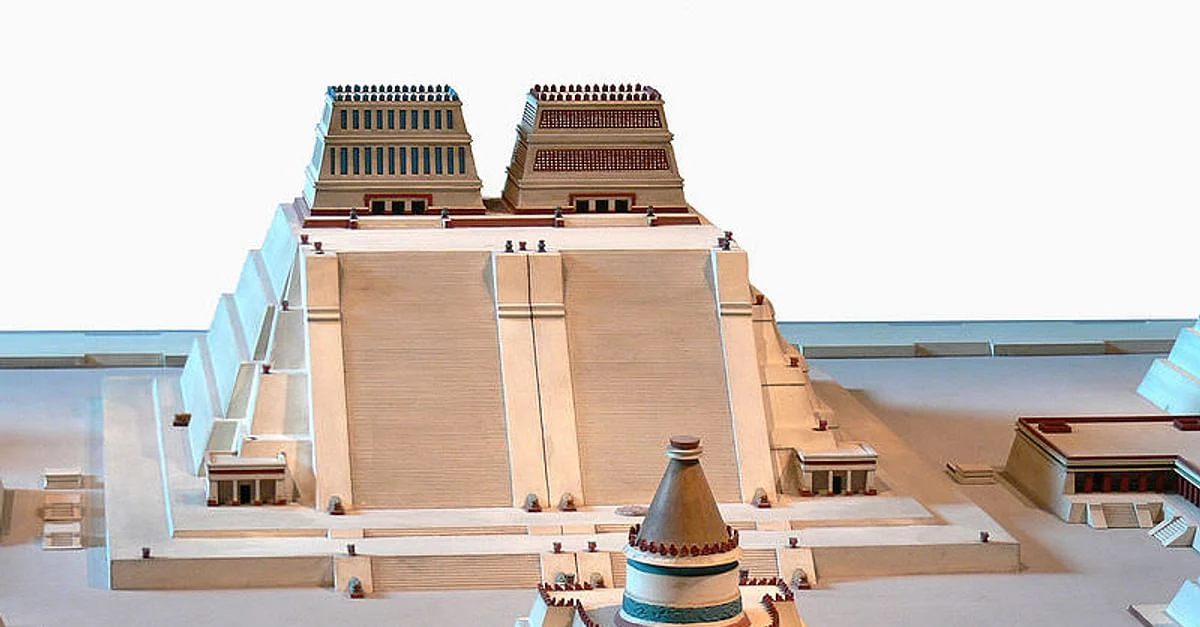
➼ Coyolxauhqui “She of the Golden Bells”
Details
1469
volcanic stone
Found in Museum of the Templo Mayor, Mexico City
Form
Circular relief sculpture.
Once brilliantly painted.
So called because of the bells she wears as earrings.
Context
Coyolxauhqui and her many brothers plotted the death of her mother, Coatlicue, who became pregnant after tucking a ball of feathers down her bosom.
When Coyolxauhqui chopped off Coatlicue’s head, a child, Huitzilopochtli, popped out of the severed body fully grown and dismembered Coyolxauhqui, who fell dead at the base of the shrine.
This stone represents the dismembered moon goddess, Coyolxauhqui, who is placed at the base of the twin pyramids of Tenochtitlán.
Aztecs sacrificed people and then threw their dismembered remains down the steps of the temple as Huitzilopochtli did to Coyolxauhqui.
Aztecs similarly dismembered enemies and threw them down the stairs of the great pyramid to land on the sculpture of Coyolxauhqui.
A relationship was established between the death and decapitation of Coyolxauhqui with the sacrifice of enemies at the top of Aztec pyramids.
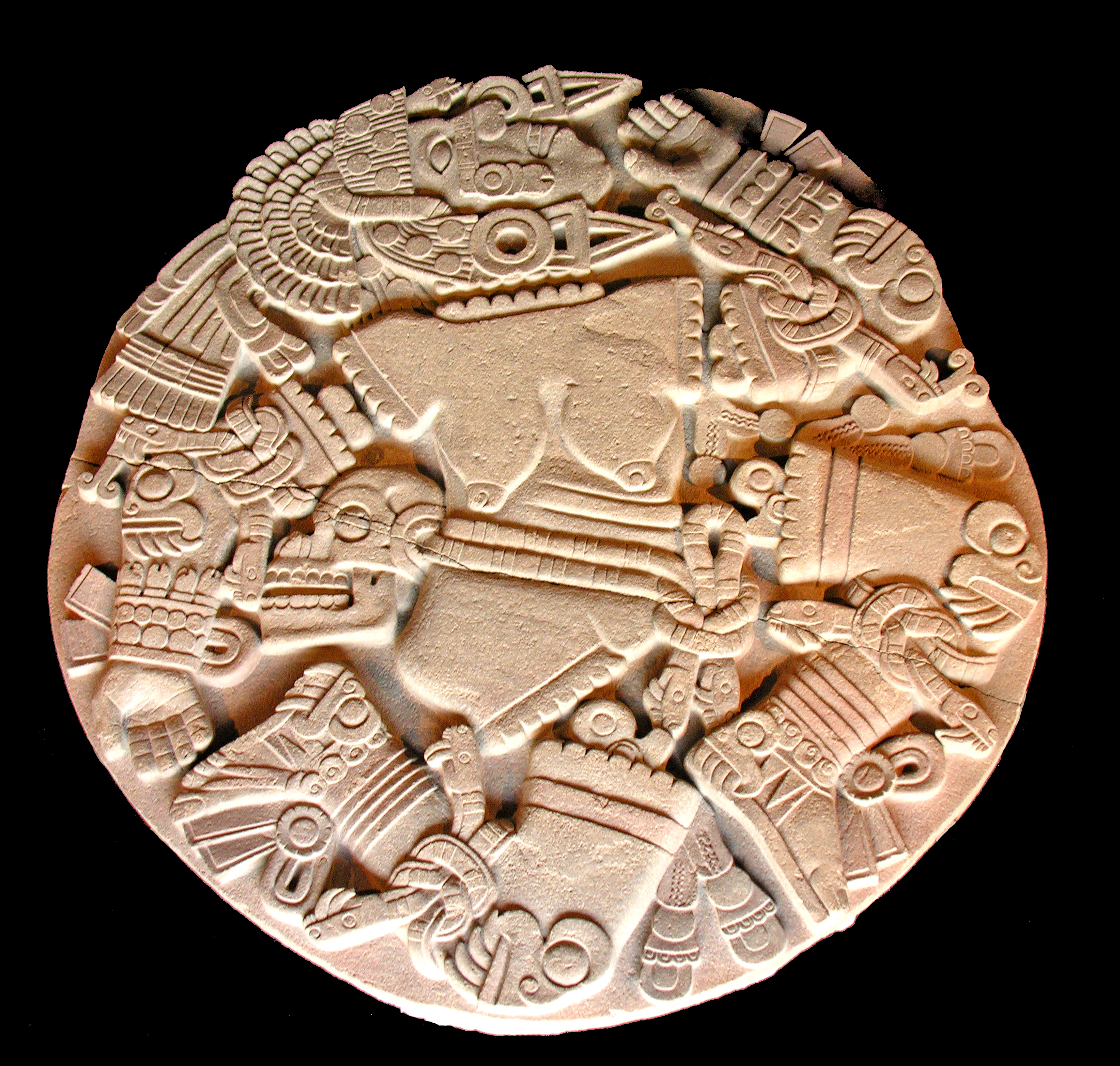
➼ Calendar Stone
Form: Made of basalt.
Context
Aztecs felt they needed to feed the sun god human hearts and blood.
A tongue in the center of the stone coming from the god’s mouth is a representation of a sacrificial flint knife used to slash open the victims.
Circular shape reflects the cyclic nature of time.
Two calendar systems, separate but intertwined.
Calendars synced every fifty-two years in a time of danger, when the Aztecs felt a human sacrifice could ensure survival.
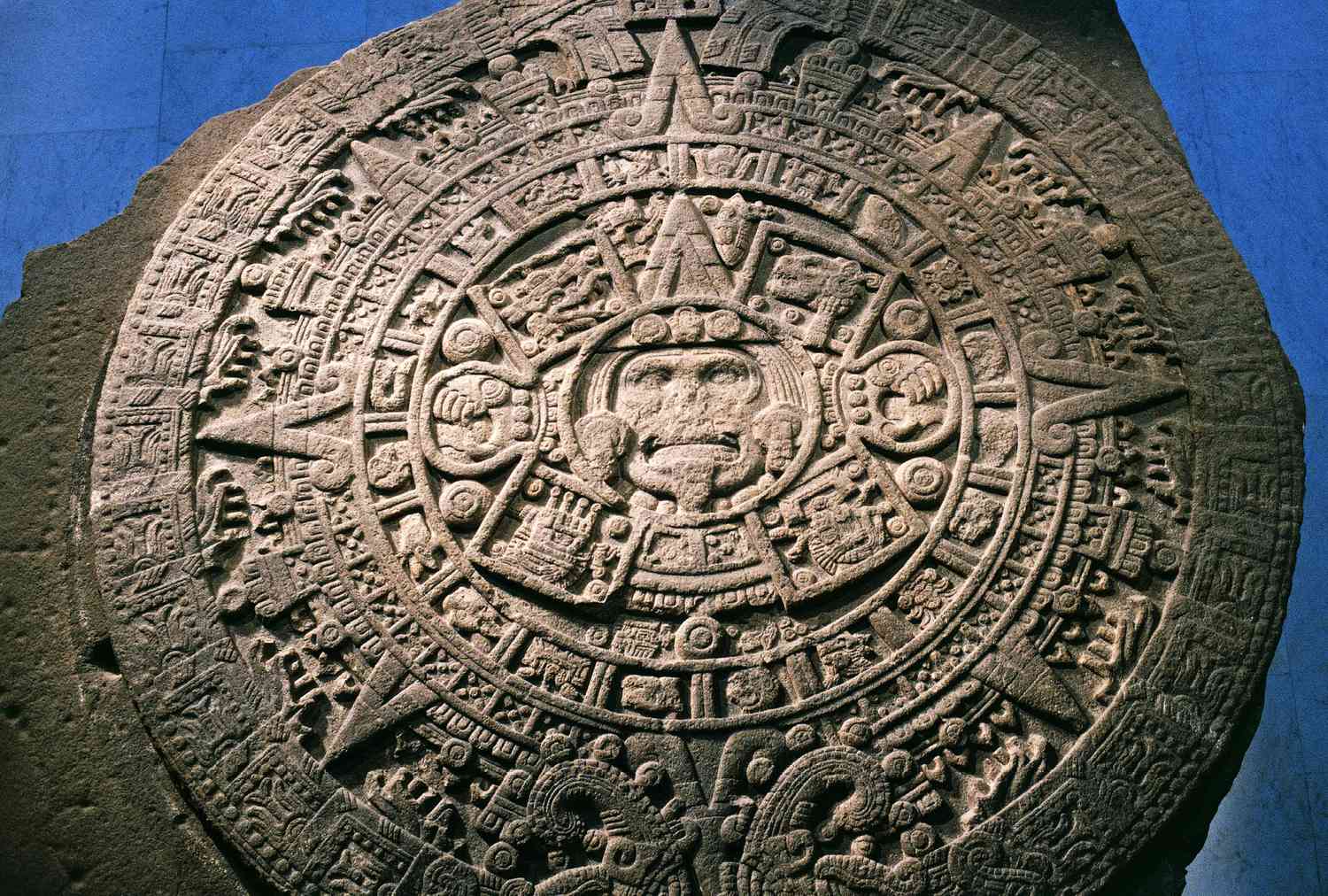
➼ Olmec-style Mask
Form: Made of jadeite.
Context
Found on the site; actually a much older work executed by the Olmecs.
Olmec works have a characteristic frown on the face; pugnacious visage; baby face; a cleft in the center of the head carved from greenstone.
Shows that the Aztecs collected and embraced artwork from other cultures, including early Mexican cultures such as the Olmec and Teotihuacán.
Shows that the Aztecs had a wide-ranging merchant network that traded historical items.
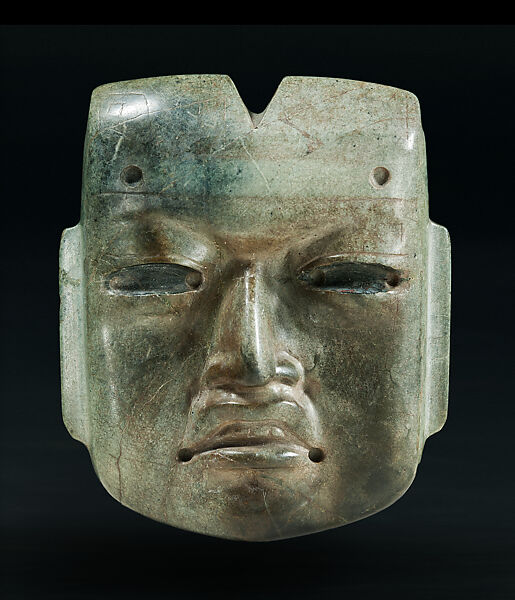
➼ Ruler’s Feather Headdress
Details:
1428–1520
feathers (quetzal and blue cotinga) and gold
Found in Museum of Ethnology, Vienna
Form
Made from 400 long green feathers, the tails of the sacred quetzal birds; male birds produce only two such feathers each.
The number 400 symbolizes eternity.
Function
Ceremonial headdress of a ruler.
Part of an elaborate costume.
Context
Only known Aztec feather headdress in the world.
Feathers indicate trading across the Aztec Empire.
Headdress possibly part of a collection of artifacts given by Motechuzoma (Montezuma) to Cortez for Charles V of the Holy Roman Empire.
Current dispute over ownership of the headdress; today it is housed in the Museum of Ethnology in Vienna, Austria.
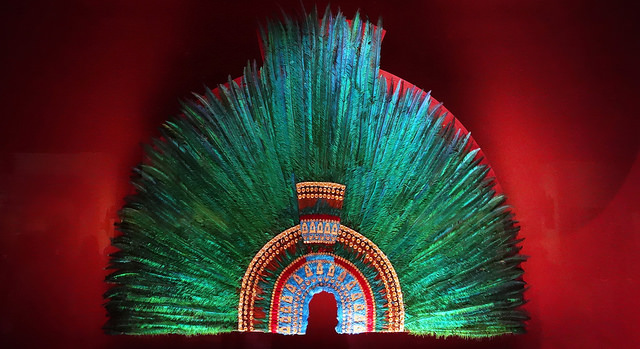
➼ Maize cobs
Details
c. 1440–1533
sheet metal/repoussé, metal alloys
Found in Staatliche Museen zu Berlin
Technique and Form
Repoussé technique.
Hollow metal object.
Life-size.
Function
May have been part of a garden in which full-sized metal sculptures of maize plants and other items were put in place alongside actual plants in the Qorinkancha garden.
May have been used to ensure a successful harvest.
Context
Maize was the principal food source in the Andes.
Maize was celebrated by having sculptures fashioned out of sheet metal.
Black maize was common in Peru; oxidized silver reflects that.
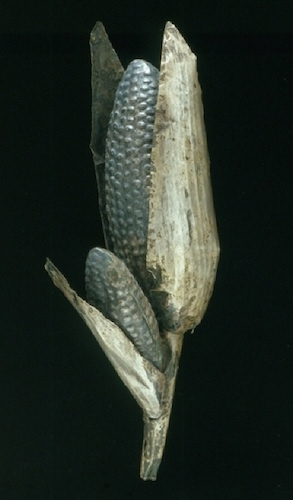
➼ Qorikancha
Details
main temple, church, and convent of Santo Domingo
c. 1440, convent added 1550–1650
Andesite
Found in Cusco, Peru
Form
Ashlar masonry; carefully grooved and beveled edges of the stone fit together in a puzzle-like formation.
Slight spacing among stones allows movement during earthquakes.
Walls taper upward; examples of Inkan trapezoidal architecture.
Temple displays Inkan use of interlocking stonework of great precision.
Original exterior walls of the temple were decorated in gold to symbolize sunshine.
Spanish chroniclers insist that the walls and floors of the temple were covered in gold.
Function
Qorikancha: golden enclosure; once was the most important temple in the Inkan world.
Once was an observatory for priests to chart the skies.
Context
The location is important; placed at the convergence of the four main highways and connected to the four districts of the empire; the temple cemented the symbolic importance of religion, uniting the divergent cultural practices that were observed in the vast territory controlled by the Inkas.
Remains of the Inkan Temple of the Sun form the base of the Santo Domingo convent built on top.

➼ Walls at Saqsa Waman (Sacsayhuaman)
Details
c. 1440
Sandstone
Found in Peru
Form
Ashlar masonry.
Ramparts contain stones weighing up to seventy tons, brought from a quarry two miles away.
Context: Complex outside the city of Cusco, Peru, at the head of the puma-shaped plan of the city.
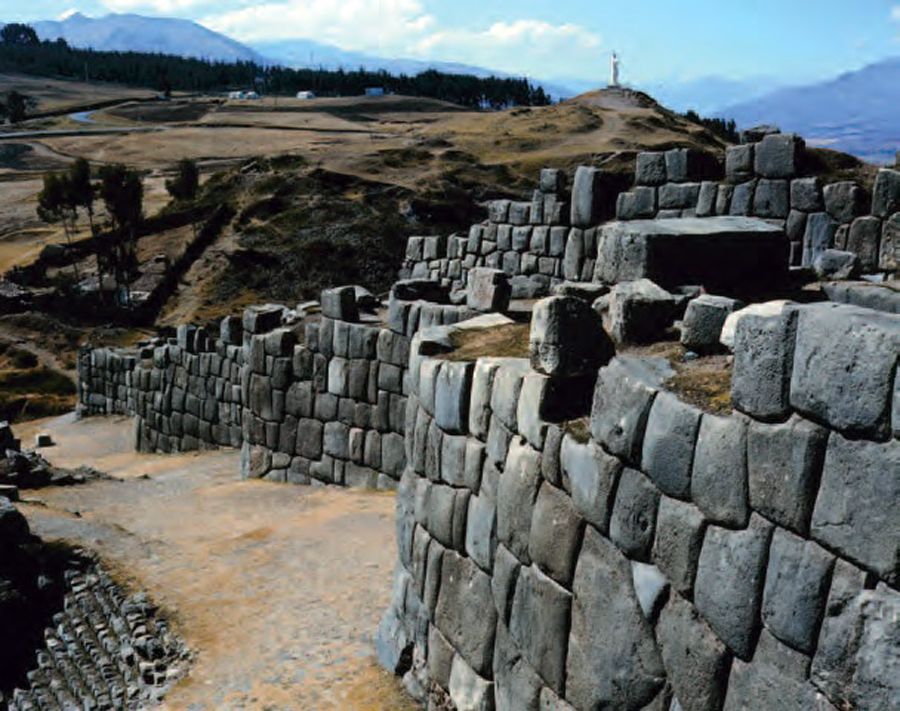
➼ Machu Picchu
Details
1450–1540
Granite
Found in Central Highlands, Peru
Form
Buildings built of stone with perfectly carved rock rendered in precise shapes and grooved together; thatched roofs.
Outward faces of the stones were smoothed and grooved.
Two hundred buildings, mostly houses; some temples, palaces, and baths, and even an astronomical observatory; most in a basic trapezoidal shape.
Entryways and windows are trapezoidal.
People farmed on terraces.
Function
Originally functioned as a royal retreat.
The estate of fifteenth-century Inkan rulers.
So remote that it was probably not used for administrative purposes in the Inkan world.
Peaceful center: many bones were uncovered, but none of them indicate war-like behavior.
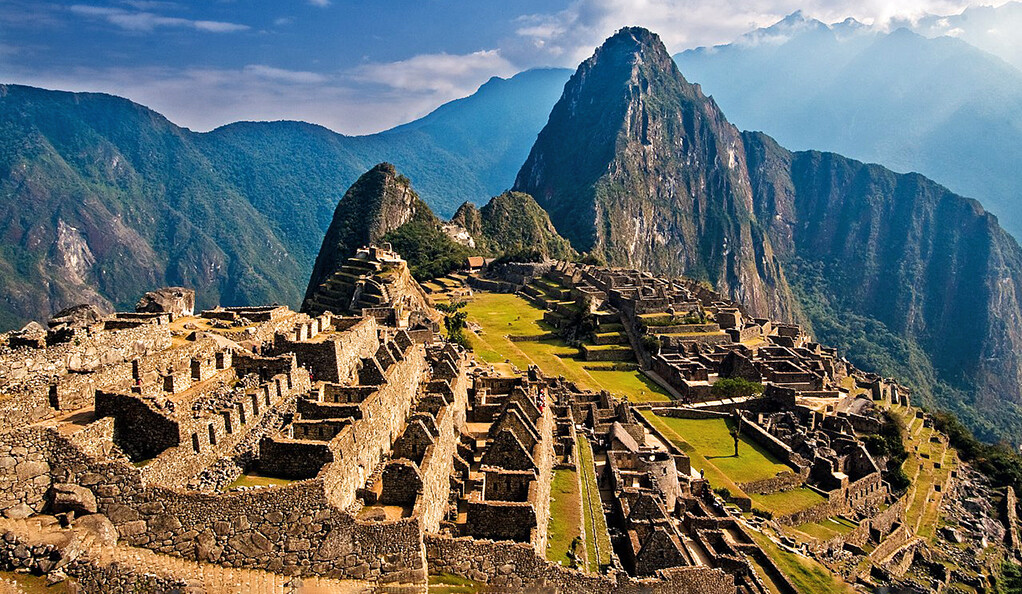
➼ Observatory in Machu Picchu
Details
1450–1540
Granite
Found in Peru
Form
Ashlar masonry.
Highest point at Machu Picchu.
Function
Used to chart the sun’s movements; also known as the Temple of the Sun.
Left window: sun shines through on the morning of the winter solstice.
Right window: sun shines through on the morning of the summer solstice.
Devoted to the sun god.
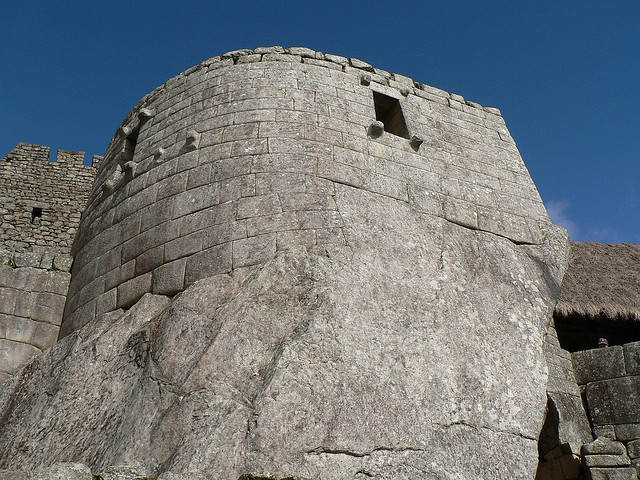
➼ Intihuatana Stone in Machu Picchu
Context
Intihuatana means “hitching post of the sun”; aligns with the sun at the spring and the autumn equinoxes, when the sun stands directly over the pillar and thus creates no shadow.
Inkan ceremonies held in concert with this event.
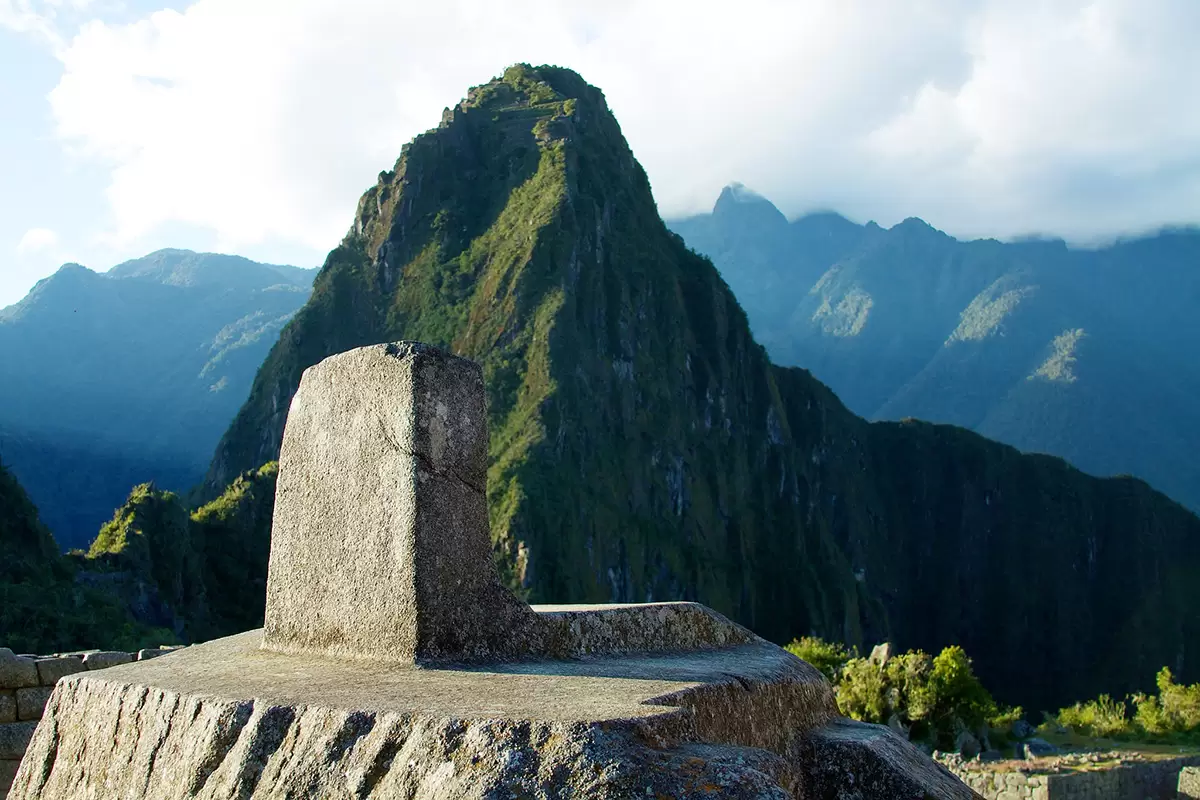
➼ All-T’oqapu Tunic
Details
1450–1540
camelid fiber and cotton
Found in Dumbarton Oaks, Washington, D.C.
Form
Rectangular shape; a slit in the center is for the head; then the tunic is folded in half and the sides are sewn for the arms.
The composition is composed of small rectangular shapes called t’oqapu.
Individual t’oqapu may be symbolic of individuals, events, or places.
This tunic contains a large number of t’oqapu.
Function
Wearing such an elaborate garment indicates the status of the individual.
May have been worn by an Inkan ruler.
Technique
Woven on a backstrap loom.
One end of the loom is tied to a tree or a post and the other end around the back of the weaver.
The movement of the weaver can create alternating tensions in the fabric and achieve different results.
Context
Exhibits Inkan preference for abstract designs, standardization of designs, and an expression of unity and order.
Finest textiles made by women, a highly distinguished art form; this tunic has a hundred threads per square centimeter.
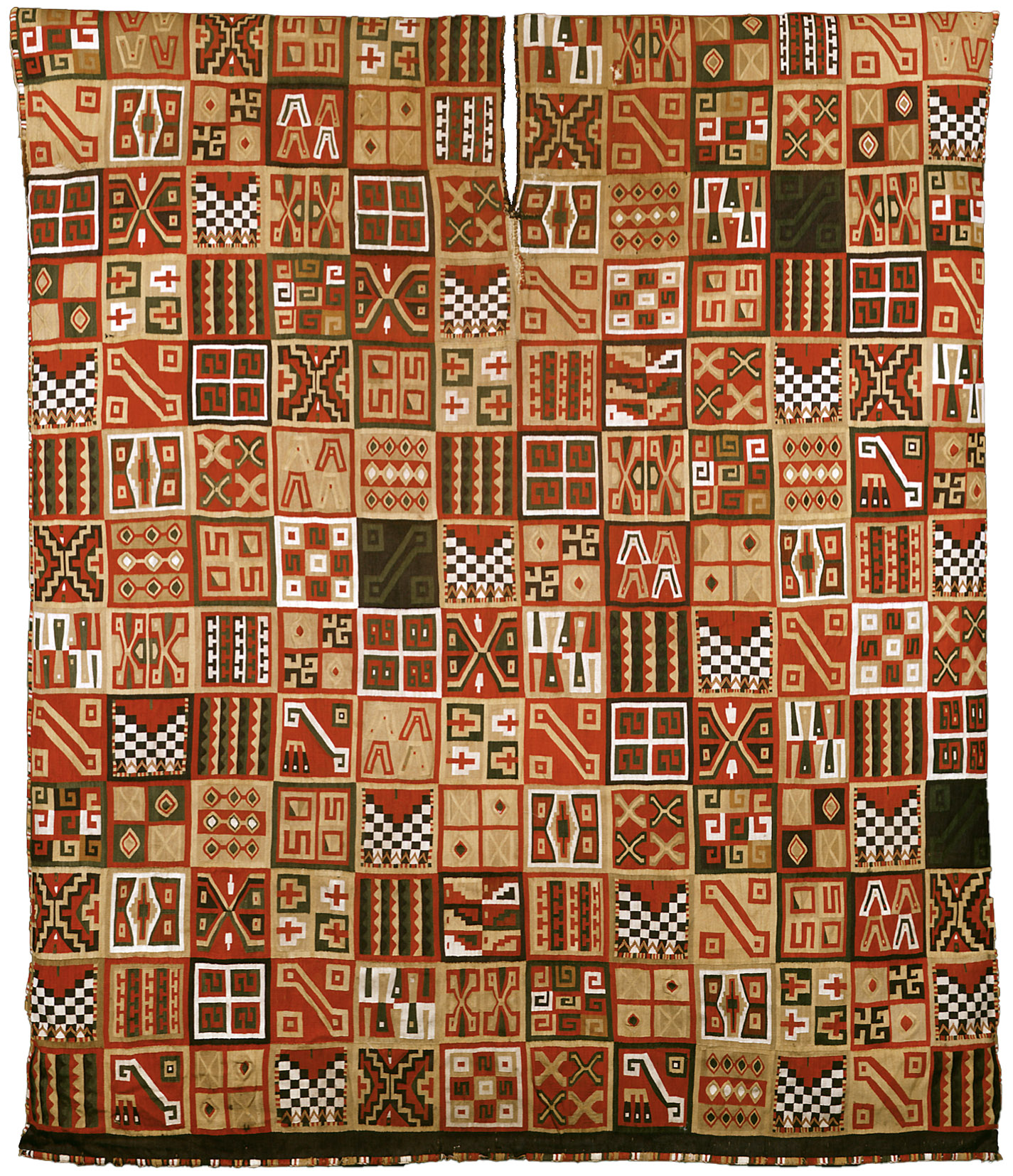
➼ Bandolier Bag
Details
From Lenape (Delaware tribe, Eastern Woodlands)
c. 1850
beadwork on leather
Found in Museum of the American Indian
Form
The bandolier bag has a large, heavily beaded pouch with a slit on top.
The bag was held at hip level with strap across the chest.
The bag was constructed of trade cloth: cotton, wool, velvet, or leather.
Function
It was made for men and women; objects of prestige.
They were made by women.
Functional and beautiful; acted also as a status symbol as part of an elaborate garb.
Bandolier bags are still made and worn today.
Context
Beadwork not done in the Americas before European contact.
Beads and silk ribbons were imported from Europe.
The bags contain both Native American and European motifs.
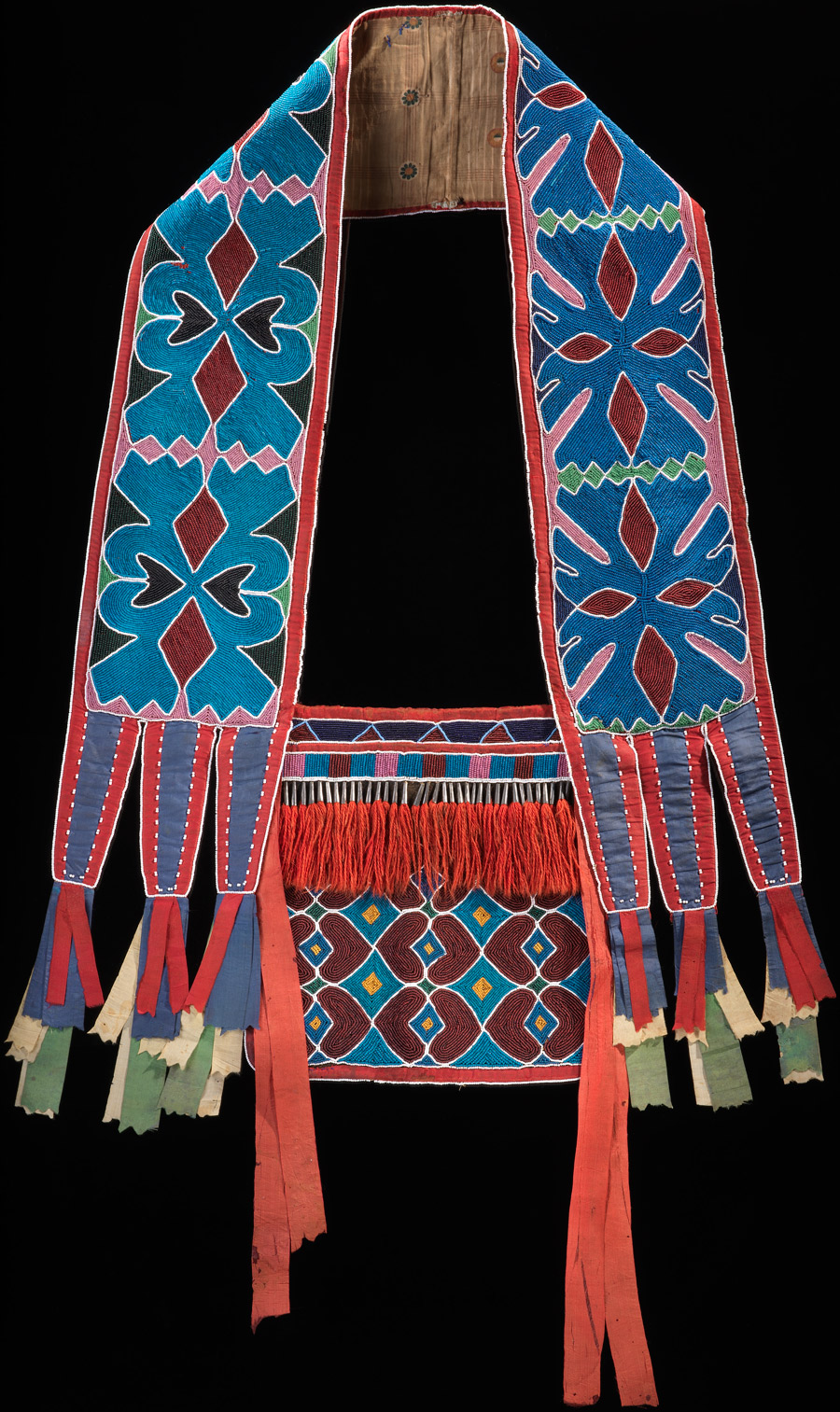
➼ Transformation Mask
Details
From Kwakwaha’wakw, Northwest Coast of Canada
late 19th century
wood, paint, and string
Found in Musée du Quai Branly-Jacques Chirac, Paris, France
Form: The mask has a birdlike exterior face; when opened, it reveals a second human face on the interior.
Function
The masks were worn by native people of the Pacific. Northwest, centered on Vancouver Island.
They were worn over the head as part of a complete body costume.
Context
During a ritual performance, the wearer opens and closes the transformation mask using strings.
At the moment of transformation, the performer turns his back to the audience to conceal the action and heighten the mystery.
Opening the mask reveals the face of an ancestor; there is an ancestral element to the ceremony.
Although these masks could be used at a potlatch, most often they were used in winter initiation rites ceremonies.
The ceremony is accompanied by drumming and takes place in a “big house.”
Masks are highly prized and often inherited.
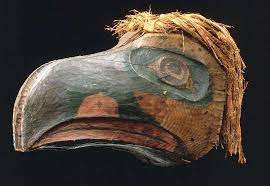
➼ Hide Painting of the Sun Dance
Details
Attributed to Cotsiogo (Cadzi Cody)
Painted elk hide, Eastern Shoshone, Wind River Reservation, Wyoming,
c. 1890–1900,
Found in Brooklyn Museum, Brooklyn, New York
Content
Depicts traditional aspects of the Plains people’s culture that were nostalgic rather than practical: bison hunted with bow and arrow—nomadic hunting gone; bison nearly extinct.
Hide paintings mark past events.
Bison considered to be gifts from the Creator.
Horses, in common use around 1750, liberated the Plains people.
Teepee: made of hide stretched over poles:
Exterior poles reach the spirit world or sky.
Fire represents the heart.
The doorway faces east to greet the new day.
The sun dance was conducted around a bison head, and was outlawed by the U.S. government; viewed as a threat to order.
The sun dance involved men dancing, singing, preparing for the feast, drumming, and constructing a lodge. They honored the Creator deity for the bounty of the land.
The warrior’s deeds were celebrated on the hide.
Function
Worn as a robe over the shoulders of the warrior.
Perhaps a wall hanging.
Context
Depicts biographical details; personal accomplishments; heroism; battles.
Men painted hides to narrate an event.
Eventually, painted hides were made for European and American markets; tourist trade.
Used paint and dyes obtained through trade.
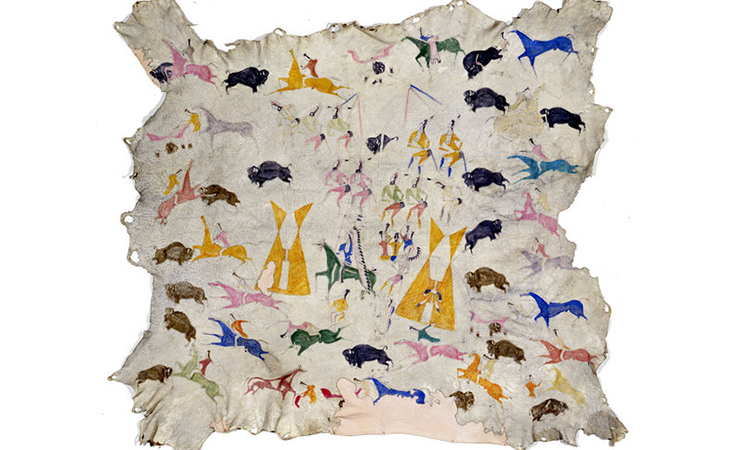
➼ Black-on-black Ceramic Vessel
Details
By Maria Martínez and Julian Martínez
From Tewa, Puebloan, San Ildefonso Pueblo, New Mexico, mid-20th century
blackware ceramic
Found in Smithsonian Museum of American Art, Washington, D.C..
Form
Black-on-black vessel.
Highly polished surface.
Contrasting shiny black and matte black finishes.
Exceptional symmetry; walls of even thickness; surfaces free of imperfections.
Function
Comes from the thousand-year-old tradition of pottery making in the Southwest.
Maria Martínez preferred making pots using a new technique that rendered a vessel lightweight, less hard, and not watertight, as traditional pots were; this kind of vessel reflected the market shift away from utilitarian vessels to decorative objects.
Technique
Used a mixture of clay and volcanic ash.
The surface was scraped to a smooth finish with a gourd tool and then polished with a stone.
Julian Martínez painted designs with a liquid clay that yielded a matte finish in contrast with the high shine of the pot itself.
Context
At the time of production, pueblos were in decline; modern life was replacing traditional life.
Artists’ work sparked a revival of pueblo techniques.
Maria Martínez, the potter, developed and invented new shapes beyond the traditional pueblo forms.
Julian Martínez, the painter of the pots, revived the use of ancient mythic figures and designs on the pots.
Reflects an influence of Art Deco designs popular at the time.
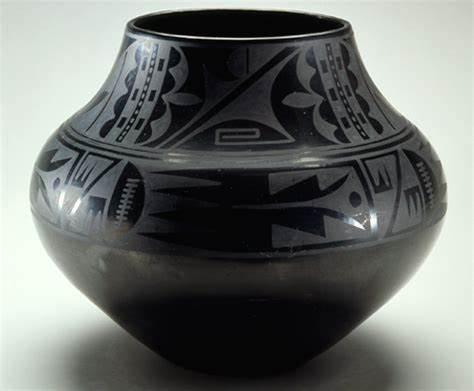
Unit 5: Indigenous Americas, 1000 BCE–1980 CE
Contextualization of Indigenous Americas Art
Chavin: Their art created intricate stone carvings and pottery, often depicting their gods and animals.
Mayan: They were known for their elaborate architecture, intricate carvings, and colorful murals.
Anasazi: They created beautiful pottery and rock art, often depicting their daily lives and spiritual beliefs.
Mississippian: They produced intricate copper and shell ornaments, as well as impressive earthen mounds.
Aztec: They were skilled in metalworking, creating intricate gold and silver jewelry, as well as colorful featherwork.
Incan: They were known for their impressive stonework, including the famous Machu Picchu.
Native North American: Their art varied greatly depending on the tribe, but often included intricate beadwork, basketry, and carvings.
Materials, Processes and Techniques in Indigenous American Art
Mesoamerica
They used stone, clay, wood, feathers, shells, and precious metals such as gold and silver.
Stones were used to create sculptures, buildings, and other structures.
Their processes include carving, casting, weaving, and painting.
Carving: Used create sculptures and other objects out of stone, while casting was used to create metal objects.
Weaving: Used to create textiles, which were often decorated with intricate designs.
Painting: Used to decorate buildings, sculptures, and other objects, and often used bright colors and bold designs.
Techniques used in Mesoamerican art include relief sculpture, mosaic, and inlay.
Relief sculpture: Involves carving a design into a flat surface, while mosaic involves creating a design out of small pieces of stone or other materials.
Inlay: Involves setting small pieces of one material into another material to create a design.
Central Andes
Pre-Columbian art used gold, silver, and copper to create intricate jewelry and ceremonial objects, and textiles were also important.
During colonial times, European materials were introduced, leading to new painting techniques like the Cuzco School.
Today, artists use a variety of materials and techniques, blending traditional and contemporary styles, experimenting with new materials, and exploring different art forms.
Native North America
Natural materials like wood, stone, bone, and animal hides, as well as trade materials like glass beads, metals, and textiles are used.
Art is created through carving, weaving, painting, and quilling.
Basketry, pottery, and jewelry making are common techniques.
These methods reflect cultural and spiritual beliefs and can tell stories, record history, or celebrate events.
Traditional methods have adapted to modern materials and technologies.
Indigenous Americas Artworks
➼ Chavín de Huántar
Details
900–200 B.C.E.
Stone
Found in Northern Highlands, Peru
Function
A religious capital.
Temple, 60 meters tall, was adorned with a jaguar sculpture, a symbol of power.
Hidden entrance to the temple led to stone corridors.
Relief sculpture
Shows jaguars in shallow relief.
Located on the ruins of a stairway at Chavín.

➼ Lanzón Stone
Details
900–200 B.C.E.
Granite
Found in Peru
Form
Inside the old temple of Chavín is a mazelike system of hallways.
Passageways have no natural light source; they are lit by candles and lamps.
At the center, underground, is the Lanzón (Spanish for “blade”) Stone; blade shaped; may also represent a primitive plough; hence, the role of the god in ensuring a successful crop.
Depicts a powerful figure that is part human (body) and part animal (claws, fangs); the god of the temple complex.
Head of snakes and a face of a jaguar.
Eyebrows terminate in snakes.
Flat relief; designs in a curvilinear pattern.
15 feet tall.
Function
Served as a cult figure.
Center of pilgrimage; however, few had access to the Lanzón Stone.
Modern scholars hypothesize that the stone acted as an oracle; hence a point of pilgrimage.
New studies show the importance of acoustics in the underground chamber.

➼ Nose Ornament
Details
hammered gold alloy
Found in Cleveland Museum of Art
Form
Worn by males and females under the nose.
Held in place by the semicircular section at the top.
Two snake heads on either end.
Function: Transforms the wearer into a supernatural being during ceremonies.
Context
Elite men and women wore the ornaments as emblems of their ties to the religion and eventually were buried with them.
The Chavín religion is related to the appearance of the first large-scale precious metal objects; revolutionary new metallurgical process.
Technical innovations express the “wholly other” nature of the religion.

➼ Yaxchilán
Details
725 CE
limestone
Found in Chiapas, Mexico
Function
City set on a high terrace; plaza surrounded by important buildings.
Flourished c. 300–800 C.E.
➼ Structure 40
Details
Overlooks the main plaza.
Three doors lead to a central room decorated with stucco.
Roof remains nearly intact, with a large roof comb (ornamented stone tops on roofs).
Corbel arch interior.
Patronage: Built by ruler Bird Jaguar IV for his son, who dedicated it to him.

➼ Lintel 25, Structure 23
Details
Overlooks the main plaza.
Three doors lead to a central room decorated with stucco.
Roof remains nearly intact, with a large roof comb (ornamented stone tops on roofs).
Corbel arch interior.
Form and Content
The lintel was originally set above the central doorway of Structure 23 as a part of a series of three lintels.
Lady Xook (bottom right) invokes the Vision Serpent to commemorate her husband’s rise to the throne.
The Vision Serpent has two heads: one has a warrior emerging from its mouth, and the other has Tlaloc, a war god.
She holds a bowl with bloodletting ceremonial items: stinging spine and bloodstained paper; she runs a rope with thorns through her tongue.
She burns paper on a dish as a gift to the netherworld.
The depicted ritual was conducted to commemorate the accession of Shield Jaguar II to the throne.
Function
Lintels intended to relay a message of the refoundation of the site—there was a long pause in the building’s history.
Shield Jaguar’s building program throughout the city may have been an attempt to reinforce his lineage and his right to rule.
Context
The building is dedicated to Lady Xook, Shield Jaguar II’s wife.
The inscription is written as a mirror image—extremely unusual among Mayan glyphs; uncertain meaning, perhaps indicating she had a vision from the other side of existence and she was acting as an intercessor or shaman.
The inscription names the protagonist as Shield Jaguar II.
Bloodletting is central to the Mayan life. When a member of the royal family sheds his or her blood, a portal to the netherworld is opened and gods and spirits enter the world.
Theory: Some scholars suggest that the serpent on this lintel and elsewhere depicts an ancestral spirit or founder of the kingdom.

➼ Structure 33
Details
Overlooks the main plaza.
Three doors lead to a central room decorated with stucco.
Roof remains nearly intact, with a large roof comb (ornamented stone tops on roofs).
Corbel arch interior.
Form
Restored temple structure.
Remains of roof comb with perforations.
Three central doorways lead to a large single room.
Corbel arch interior.

➼ Mesa Verde Cliff Dwellings
Details
Ancestral Puebloan (Anasazi)
450–1300 C.E.
Sandstone
Found in Montezuma County, Colorado
Form
The top ledge houses supplies in a storage area; cool and dry area out of the way; accessible only by ladder.
Each family received one room in the dwelling.
Plaza placed in front of the abode structure; kivas face the plaza.
Function
The pueblo was built into the sides of a cliff, housed about one hundred people.
Clans moved together for mutual support and defense.
Context
Farming done on the plateau above the pueblo; everything had to be imported into the structure; water seeped through the sandstone and collected in trenches near the rear of the structure.
Low winter sun penetrated the pueblo; high summer sun did not enter the interior and therefore it stayed relatively cool.
Inhabited for two hundred years; probably abandoned when the water source dried up.

➼ Great Serpent Mound
Details
Mississippian (Eastern Woodlands)
c. 1070 C.E.
earthwork/effigy mound
Found in Adams County, southern Ohio
Context
Many mounds were enlarged and changed over the years, not built in one campaign.
Effigy mounds popular in Mississippian culture.
Associated with snakes and crop fertility.
There are no burials associated with this mound, though there are burial sites nearby.
Theories
Influenced by comets? Astrological phenomenon? Head pointed to summer solstice sunset?
Theory that it could be a representation of Halley’s Comet in 1066.
Rattlesnake as a symbol in Mississippian iconography; could this play a role in interpreting this mound?

➼ Templo Mayor (Main Temple)
Details
1375–1520
Stone
Found in Tenochtitlán, Mexico City, Mexico
Form
Pyramids built one atop the other so that the final form encases all previous pyramids; seven building campaigns.
Pyramids have a step-like series of setbacks; not the smooth-surfaced pyramids seen in Egypt.
Characterized by four huge flights of very vertical steps leading to temples placed on top.
Function
Tenochtitlán was laid out on a grid; city seen as the center of the world.
The temple structures on top of each pyramid were dedicated to and housed the images of the two important deities.
Context
Two temples atop a pyramid, each with a separate staircase:
North: dedicated to Tlaloc, god of rain, agriculture.
South: dedicated to Huitzilopochtli, god of sun and war.
At the spring and autumn equinoxes, the sun rises between the two.
Large braziers put on top where the sacred fires burned.
Temple structures housed images of the deities.
Temples begun in 1375; rebuilt six times; destroyed by the Spanish in 1520.
The destruction of this temple and reuse of its stones by the Spanish asserted a political and spiritual dominance over the conquered civilization.

➼ Coyolxauhqui “She of the Golden Bells”
Details
1469
volcanic stone
Found in Museum of the Templo Mayor, Mexico City
Form
Circular relief sculpture.
Once brilliantly painted.
So called because of the bells she wears as earrings.
Context
Coyolxauhqui and her many brothers plotted the death of her mother, Coatlicue, who became pregnant after tucking a ball of feathers down her bosom.
When Coyolxauhqui chopped off Coatlicue’s head, a child, Huitzilopochtli, popped out of the severed body fully grown and dismembered Coyolxauhqui, who fell dead at the base of the shrine.
This stone represents the dismembered moon goddess, Coyolxauhqui, who is placed at the base of the twin pyramids of Tenochtitlán.
Aztecs sacrificed people and then threw their dismembered remains down the steps of the temple as Huitzilopochtli did to Coyolxauhqui.
Aztecs similarly dismembered enemies and threw them down the stairs of the great pyramid to land on the sculpture of Coyolxauhqui.
A relationship was established between the death and decapitation of Coyolxauhqui with the sacrifice of enemies at the top of Aztec pyramids.

➼ Calendar Stone
Form: Made of basalt.
Context
Aztecs felt they needed to feed the sun god human hearts and blood.
A tongue in the center of the stone coming from the god’s mouth is a representation of a sacrificial flint knife used to slash open the victims.
Circular shape reflects the cyclic nature of time.
Two calendar systems, separate but intertwined.
Calendars synced every fifty-two years in a time of danger, when the Aztecs felt a human sacrifice could ensure survival.

➼ Olmec-style Mask
Form: Made of jadeite.
Context
Found on the site; actually a much older work executed by the Olmecs.
Olmec works have a characteristic frown on the face; pugnacious visage; baby face; a cleft in the center of the head carved from greenstone.
Shows that the Aztecs collected and embraced artwork from other cultures, including early Mexican cultures such as the Olmec and Teotihuacán.
Shows that the Aztecs had a wide-ranging merchant network that traded historical items.

➼ Ruler’s Feather Headdress
Details:
1428–1520
feathers (quetzal and blue cotinga) and gold
Found in Museum of Ethnology, Vienna
Form
Made from 400 long green feathers, the tails of the sacred quetzal birds; male birds produce only two such feathers each.
The number 400 symbolizes eternity.
Function
Ceremonial headdress of a ruler.
Part of an elaborate costume.
Context
Only known Aztec feather headdress in the world.
Feathers indicate trading across the Aztec Empire.
Headdress possibly part of a collection of artifacts given by Motechuzoma (Montezuma) to Cortez for Charles V of the Holy Roman Empire.
Current dispute over ownership of the headdress; today it is housed in the Museum of Ethnology in Vienna, Austria.

➼ Maize cobs
Details
c. 1440–1533
sheet metal/repoussé, metal alloys
Found in Staatliche Museen zu Berlin
Technique and Form
Repoussé technique.
Hollow metal object.
Life-size.
Function
May have been part of a garden in which full-sized metal sculptures of maize plants and other items were put in place alongside actual plants in the Qorinkancha garden.
May have been used to ensure a successful harvest.
Context
Maize was the principal food source in the Andes.
Maize was celebrated by having sculptures fashioned out of sheet metal.
Black maize was common in Peru; oxidized silver reflects that.

➼ Qorikancha
Details
main temple, church, and convent of Santo Domingo
c. 1440, convent added 1550–1650
Andesite
Found in Cusco, Peru
Form
Ashlar masonry; carefully grooved and beveled edges of the stone fit together in a puzzle-like formation.
Slight spacing among stones allows movement during earthquakes.
Walls taper upward; examples of Inkan trapezoidal architecture.
Temple displays Inkan use of interlocking stonework of great precision.
Original exterior walls of the temple were decorated in gold to symbolize sunshine.
Spanish chroniclers insist that the walls and floors of the temple were covered in gold.
Function
Qorikancha: golden enclosure; once was the most important temple in the Inkan world.
Once was an observatory for priests to chart the skies.
Context
The location is important; placed at the convergence of the four main highways and connected to the four districts of the empire; the temple cemented the symbolic importance of religion, uniting the divergent cultural practices that were observed in the vast territory controlled by the Inkas.
Remains of the Inkan Temple of the Sun form the base of the Santo Domingo convent built on top.

➼ Walls at Saqsa Waman (Sacsayhuaman)
Details
c. 1440
Sandstone
Found in Peru
Form
Ashlar masonry.
Ramparts contain stones weighing up to seventy tons, brought from a quarry two miles away.
Context: Complex outside the city of Cusco, Peru, at the head of the puma-shaped plan of the city.

➼ Machu Picchu
Details
1450–1540
Granite
Found in Central Highlands, Peru
Form
Buildings built of stone with perfectly carved rock rendered in precise shapes and grooved together; thatched roofs.
Outward faces of the stones were smoothed and grooved.
Two hundred buildings, mostly houses; some temples, palaces, and baths, and even an astronomical observatory; most in a basic trapezoidal shape.
Entryways and windows are trapezoidal.
People farmed on terraces.
Function
Originally functioned as a royal retreat.
The estate of fifteenth-century Inkan rulers.
So remote that it was probably not used for administrative purposes in the Inkan world.
Peaceful center: many bones were uncovered, but none of them indicate war-like behavior.

➼ Observatory in Machu Picchu
Details
1450–1540
Granite
Found in Peru
Form
Ashlar masonry.
Highest point at Machu Picchu.
Function
Used to chart the sun’s movements; also known as the Temple of the Sun.
Left window: sun shines through on the morning of the winter solstice.
Right window: sun shines through on the morning of the summer solstice.
Devoted to the sun god.

➼ Intihuatana Stone in Machu Picchu
Context
Intihuatana means “hitching post of the sun”; aligns with the sun at the spring and the autumn equinoxes, when the sun stands directly over the pillar and thus creates no shadow.
Inkan ceremonies held in concert with this event.

➼ All-T’oqapu Tunic
Details
1450–1540
camelid fiber and cotton
Found in Dumbarton Oaks, Washington, D.C.
Form
Rectangular shape; a slit in the center is for the head; then the tunic is folded in half and the sides are sewn for the arms.
The composition is composed of small rectangular shapes called t’oqapu.
Individual t’oqapu may be symbolic of individuals, events, or places.
This tunic contains a large number of t’oqapu.
Function
Wearing such an elaborate garment indicates the status of the individual.
May have been worn by an Inkan ruler.
Technique
Woven on a backstrap loom.
One end of the loom is tied to a tree or a post and the other end around the back of the weaver.
The movement of the weaver can create alternating tensions in the fabric and achieve different results.
Context
Exhibits Inkan preference for abstract designs, standardization of designs, and an expression of unity and order.
Finest textiles made by women, a highly distinguished art form; this tunic has a hundred threads per square centimeter.

➼ Bandolier Bag
Details
From Lenape (Delaware tribe, Eastern Woodlands)
c. 1850
beadwork on leather
Found in Museum of the American Indian
Form
The bandolier bag has a large, heavily beaded pouch with a slit on top.
The bag was held at hip level with strap across the chest.
The bag was constructed of trade cloth: cotton, wool, velvet, or leather.
Function
It was made for men and women; objects of prestige.
They were made by women.
Functional and beautiful; acted also as a status symbol as part of an elaborate garb.
Bandolier bags are still made and worn today.
Context
Beadwork not done in the Americas before European contact.
Beads and silk ribbons were imported from Europe.
The bags contain both Native American and European motifs.

➼ Transformation Mask
Details
From Kwakwaha’wakw, Northwest Coast of Canada
late 19th century
wood, paint, and string
Found in Musée du Quai Branly-Jacques Chirac, Paris, France
Form: The mask has a birdlike exterior face; when opened, it reveals a second human face on the interior.
Function
The masks were worn by native people of the Pacific. Northwest, centered on Vancouver Island.
They were worn over the head as part of a complete body costume.
Context
During a ritual performance, the wearer opens and closes the transformation mask using strings.
At the moment of transformation, the performer turns his back to the audience to conceal the action and heighten the mystery.
Opening the mask reveals the face of an ancestor; there is an ancestral element to the ceremony.
Although these masks could be used at a potlatch, most often they were used in winter initiation rites ceremonies.
The ceremony is accompanied by drumming and takes place in a “big house.”
Masks are highly prized and often inherited.

➼ Hide Painting of the Sun Dance
Details
Attributed to Cotsiogo (Cadzi Cody)
Painted elk hide, Eastern Shoshone, Wind River Reservation, Wyoming,
c. 1890–1900,
Found in Brooklyn Museum, Brooklyn, New York
Content
Depicts traditional aspects of the Plains people’s culture that were nostalgic rather than practical: bison hunted with bow and arrow—nomadic hunting gone; bison nearly extinct.
Hide paintings mark past events.
Bison considered to be gifts from the Creator.
Horses, in common use around 1750, liberated the Plains people.
Teepee: made of hide stretched over poles:
Exterior poles reach the spirit world or sky.
Fire represents the heart.
The doorway faces east to greet the new day.
The sun dance was conducted around a bison head, and was outlawed by the U.S. government; viewed as a threat to order.
The sun dance involved men dancing, singing, preparing for the feast, drumming, and constructing a lodge. They honored the Creator deity for the bounty of the land.
The warrior’s deeds were celebrated on the hide.
Function
Worn as a robe over the shoulders of the warrior.
Perhaps a wall hanging.
Context
Depicts biographical details; personal accomplishments; heroism; battles.
Men painted hides to narrate an event.
Eventually, painted hides were made for European and American markets; tourist trade.
Used paint and dyes obtained through trade.

➼ Black-on-black Ceramic Vessel
Details
By Maria Martínez and Julian Martínez
From Tewa, Puebloan, San Ildefonso Pueblo, New Mexico, mid-20th century
blackware ceramic
Found in Smithsonian Museum of American Art, Washington, D.C..
Form
Black-on-black vessel.
Highly polished surface.
Contrasting shiny black and matte black finishes.
Exceptional symmetry; walls of even thickness; surfaces free of imperfections.
Function
Comes from the thousand-year-old tradition of pottery making in the Southwest.
Maria Martínez preferred making pots using a new technique that rendered a vessel lightweight, less hard, and not watertight, as traditional pots were; this kind of vessel reflected the market shift away from utilitarian vessels to decorative objects.
Technique
Used a mixture of clay and volcanic ash.
The surface was scraped to a smooth finish with a gourd tool and then polished with a stone.
Julian Martínez painted designs with a liquid clay that yielded a matte finish in contrast with the high shine of the pot itself.
Context
At the time of production, pueblos were in decline; modern life was replacing traditional life.
Artists’ work sparked a revival of pueblo techniques.
Maria Martínez, the potter, developed and invented new shapes beyond the traditional pueblo forms.
Julian Martínez, the painter of the pots, revived the use of ancient mythic figures and designs on the pots.
Reflects an influence of Art Deco designs popular at the time.

 Knowt
Knowt
